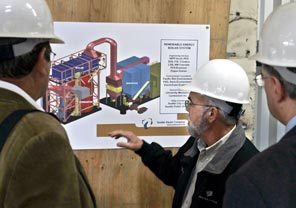Waste wood to heat downtown Seattle buildings
 The Seattle Steam Company broke ground Tuesday on a hybrid waste-wood and natural gas heating plant that will cut carbon emissions while helping heat the local business district. Starting next year, about half of downtown Seattle might be partially heated by … wood.
The Seattle Steam Company broke ground Tuesday on a hybrid waste-wood and natural gas heating plant that will cut carbon emissions while helping heat the local business district. Starting next year, about half of downtown Seattle might be partially heated by … wood.Waste wood, to be exact.
The Seattle Steam Company broke ground Tuesday on a hybrid waste-wood and natural-gas heating plant on Western Avenue near Pike Place Market.
Seattle Steam has been heating the Central Business District — first with coal, then natural gas — since 1894. Roughly 9 million square feet, or half of downtown’s buildings, including Swedish Medical Center, Seattle University, Benaroya Hall and the Central Branch of the Seattle Public Library, are served by its piped-steam system.
Combusting waste wood closes the “carbon loop,” said Patrick Mazza, research director for Climate Solutions, a Seattle-based research and advocacy group.
“You’re contrasting a fuel source that has been notably volatile in terms of price with a local, renewable fuel source,” he said. “It’s one of those things that we know to do well, but that we’ve kind of forgot during the age of cheap energy.”
Using wood that would be otherwise rot in a landfill is a way of reducing Seattle Steam’s consumption of natural gas.
The $25 million facility, slated to open by July, is not a prototype. It’s a heating plant that will supplement the existing natural-gas boilers at the existing steam-generating plant. About 60 percent of the new boiler’s energy will be supplied by wood recycled from urban construction sites, sawmills, factory crates and pallets, and other products.
The remaining 40 percent will still be supplied by natural gas; the boiler is designed to use both. The wood will be delivered by a contractor that removes nails and other metal and trims the waste down to 3-inch chips; once the waste is burned, the ash is collected in a silo and sold to concrete companies.
The boiler will produce about 85,000 pounds of steam per hour, and will run 24 hours a day, seven days a week, said Randy Erickson, a Seattle Steam senior engineering technician and one of the project’s managers.
“If this thing isn’t running, somebody will be asking why,” he said.
It’s one of the big-ticket items in the city’s attempt to reduce its total carbon-dioxide emissions and meet or exceed the standards set by the 1997 Kyoto Protocol. The biomass boiler’s use of wood waste will prevent 50,000 metric tons of carbon from being released each year, a 6 to 8 percent reduction and a key part of the goal set by Seattle Mayor Greg Nickels for 600,000 fewer tons per year, said Mike Mann, acting director of the city’s Office of Sustainability and Environment.
“The innovation is that it has not been done on this type of scale in many American cities, replacing a fossil fuel with a renewable resource,” Mann said.
Once natural gas becomes expensive enough to warrant alternative fuels, cities and large institutions, such as public universities, become more willing to investigate.
A similar facility is operational in Vancouver, B.C., and in cities in Europe, including in Denmark and Finland, said Rick Gustafson, a professor of forest resources at the University of Washington.
“Economics drive these things,” he said.
You can return to the main Market News page, or press the Back button on your browser.

